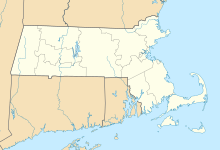| Battle of Bloody Brook | |||||||
|---|---|---|---|---|---|---|---|
| Part of King Philip's War | |||||||
 Monument to the Battle of Bloody Brook, South Deerfield. | |||||||
| |||||||
| Belligerents | |||||||
|
Norwottuck Woronoco Wampanoag | Mohegans | ||||||
| Commanders and leaders | |||||||
|
Sangumachu Sagamore Sam Penchason Tatason |
Thomas Lathrop † Samuel Mosely Attawamhood | ||||||
| Strength | |||||||
| 500-700 warriors |
67 Essex County troops 17 English teamsters 230 reinforcements | ||||||
| Casualties and losses | |||||||
| Unknown |
at least 58 militia killed at least 16 civilians killed | ||||||
Location of the battle in modern Massachusetts | |||||||
The Battle of Bloody Brook was fought on September 28, 1675 (September 18, 1675 OS) between an indigenous war party primarily composed of Pocumtuc warriors and other local indigenous people from the central Connecticut River valley, and the English colonial militia of the New England Confederation and their Mohegan allies during King Philip's War.
The crop fields of the Pocumtuc and other Connecticut River valley nations were desired by the English, however the Pocumtuc in particular were resistant to ceding their land. The Pocumtuc were the dominant power in the central Connecticut river valley, orchestrating powerful alliances and forcing the English-allied Mohegans into tribute. However, after a 1664 war with the Kanienkehaka (Mohawk) fractured both nations and destabilized the region, the Pocumtuc were compelled to begin selling land.
Subsequently, the Connecticut River valley would represent the western border of the Massachusetts Bay Colony. However, English involvement in the Pocumtuc-Kanienkehaka war, and subsequent dealings in obtaining Pocumtuc land, contributed to local and region-wide resentment against English inhabitation of New England. Although the English were tolerated, the Pocumtuc Confederacy quickly joined Metacomet's forces at the outbreak of King Philip's War.
In the early stages of King Philip's War, English forces in the Southern Theatre experienced many smaller defeats on the western frontline, which sent the English scrambling to reinforce their settlements in the Connecticut River valley. Looking to act defensively in this Connecticut River campaign, the English set out to gather the considerable amount of corn grown at Pocumtuc (Deerfield) to feed their garrisons.
Led by Pocumtuc sachem Sangumachu, the Pocumtuc Confederacy was reinforced by their Nipmuc and Wampanoag allies. The Indigenous war party ambushed and annihilated a company of militia escorting a train of wagons carrying the harvest from Pocumtuc to Hadley in the Connecticut River valley, killing at least 58 militia men and 16 teamsters. A short while after, this was followed by an extended battle against waves of pro-English reinforcements.
The battle had a significant impact on English consciousness in the war. This major defeat amongst others elicited aggressive responses by the English, such as a preventive war against the Narragansett that winter, and the 1676 Peskeompscut Massacre, which ended Indigenous dominance of the Connecticut River valley. Pocumtuc refugees fled to New York and the Wabanaki Confederacy. Bloody Brook was particularly commemorated by Euro-American residents of Massachusetts in the 1800s.
© MMXXIII Rich X Search. We shall prevail. All rights reserved. Rich X Search

